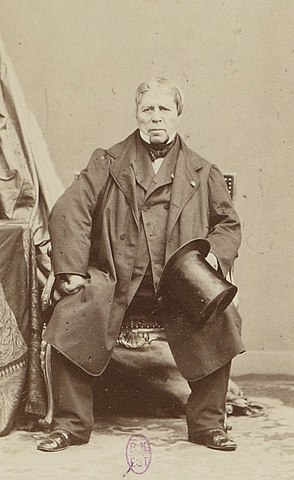
Born: 29 August 1780, Montauban
Died: 14 January 1867 (aged 86)
Period: Neoclassicism
The Life of Jean Auguste Dominique Ingres
Jean Auguste Dominique Ingres was a French painter who became one of the principal exponents of the Neoclassical style during the first half of the 19th century. Born in Montauban, Ingres initially trained under his father, Jean-Marie-Joseph Ingres, a minor painter and sculptor, before moving to Paris to study under Jacques-Louis David, the leading French painter of the era. David’s influence instilled in Ingres a meticulous approach to form and outline and a reverence for the classical tradition.
Ingres won the prestigious Prix de Rome in 1801, which allowed him to study at the French Academy in Rome from 1806 to 1810, and he remained in Italy for an extended period, until 1824. This experience deeply influenced his artistic orientation; he absorbed the Italian Renaissance’s lessons, which would become evident in his mastery of drawing and his passion for clarity, harmony, and balance.
Despite his affiliation with Neoclassicism, Ingres’s work often defied the period’s conventions, leading to initial criticism. His early masterpiece, “The Envoys of Agamemnon” (1801), already demonstrated his exceptional drawing skills and attention to detail. However, it was his later works, such as “The Grande Odalisque” (1814) and “The Turkish Bath” (1862), which displayed his unique approach to form and composition, that garnered him recognition and acclaim. These works, characterized by their sensual, elongated figures, reflected Ingres’s fascination with exoticism and his departure from classical proportions, which was revolutionary at the time.
Ingres was also a highly regarded portrait painter, capturing the likenesses of Europe’s elite with precision and depth. His portraits are celebrated for their psychological insight and the meticulous detail of fabric and texture, demonstrating his mastery over the medium.
Throughout his career, Ingres struggled with the artistic movements of his time, particularly Romanticism, which he saw as antithetical to his classical values. Despite these challenges, he was appointed as a professor at the École des Beaux-Arts in Paris in 1829, where he influenced a generation of artists. Ingres’s legacy is marked by his contribution to the Neoclassical movement, his dedication to the academic tradition, and his impact on the development of French art. His works are held in high esteem for their beauty, precision, and depth, bridging the gap between Neoclassicism and emerging Romantic sensibilities.
Jean Auguste Dominique Ingres’s Notable Works
Jean Auguste Dominique Ingres was a master of the 19th-century French Neoclassical tradition, known for his exquisite line work, detailed realism, and the sensuality of his subjects. His most famous works are celebrated for their beauty, precision, and depth, blending classical ideals with a personal touch that set his pieces apart. Here are ten of Ingres’s most renowned works:
- The Grande Odalisque (1814) – Commissioned by Napoleon’s sister, Queen Caroline Murat of Naples, this painting depicts an odalisque, or a harem concubine, in a manner that showcases Ingres’s departure from classical proportion for aesthetic effect, making it one of his most famous works.
- Oedipus and the Sphinx (1808) – An early masterpiece that highlights Ingres’s mastery in handling historical and mythological subjects, showcasing his skill in drawing and composition.
- The Valpinçon Bather (1808) – A study of the female form and a testament to Ingres’s ability to imbue a sense of tranquility and sensuality in his depictions of the nude.
- The Turkish Bath (1862) – One of Ingres’s late masterpieces, depicting a group of nude women in a Turkish bath, celebrated for its circular composition and the luminous quality of the flesh tones.
- Portrait of Madame Moitessier (1856) – A portrait of a Parisian socialite that stands out for its exquisite detail, especially in the depiction of fabrics and the sitter’s elegant pose, reflecting Ingres’s exceptional skill as a portraitist.
- The Apotheosis of Homer (1827) – A grandiose and detailed allegorical work that pays homage to the ancient Greek poet Homer, showcasing Ingres’s commitment to classical ideals and his ability to organize a complex composition with numerous figures.
- The Vow of Louis XIII (1824) – Commissioned for the Cathedral of Montauban, this painting is a significant religious work that demonstrates Ingres’s ability to handle large-scale compositions and his flair for dramatic storytelling.
- The Source (1856) – Another iconic nude, depicting a standing female figure holding a jug from which water flows, symbolizing purity and the classical ideal of beauty.
- Louis-François Bertin (1832) – A powerful portrait of the French journalist, celebrated for its psychological depth and the robust realism with which Ingres captures the sitter’s character.
- Jupiter and Thetis (1811) – This mythological scene exemplifies Ingres’s talent for drama and emotion, portraying the goddess Thetis pleading with Jupiter, the king of the gods, in a dynamic and emotionally charged composition.
Ingres’s body of work is a testament to his lifelong dedication to the refinement of his craft, the exploration of the human form, and the pursuit of beauty. His influence extended beyond his lifetime, shaping the course of French art and leaving a legacy that continues to captivate audiences today.